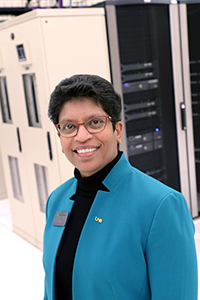Collaboration to build network capacity
University IT supports today’s connected student with major computer system upgrades

Now the team’s focus is increasing the bandwidth between the Data Center and the buildings on campus. Archival photo.
Just a decade ago, most of UND’s lecture halls and classrooms were filled with students feverishly scrawling notes in large, spiral-bound notebooks.

In 2017, paper and pencil are harder to find. Instead, the modern student is typing discussion summaries into a web-based file sharing system, digitally jotting details on their tablet or smartphone, or gathering around an interactive screen to bounce ideas back and forth.
Online and mobile devices have essentially replaced the need for a pen. UND Chief Information Officer Madhavi Marasinghe knows it.
“We need to remember that people have more than one digital device now. On average, people carry two or three devices. I, myself, have carried about six things at a time,” Marasinghe said with a laugh. “So we need more capacity.”
That’s why Marasinghe and her team are driving forward on a major network upgrade that began last fall. The first phase of updates will continue at least through March 2018.
The last time UND had a major upgrade like this was in 2009. Marasinghe says that, considering the current pace of technology, UND is long past due.
“This is a must. We are setting the stones for the next level,” Marasinghe explained, adding that the upgrades are critical to achieving the action items of the One UND Strategic Plan. “To get more online students, to create more learning opportunity, to support an increasingly BYOD (bring your own device) environment, there is intense pressure on network infrastructure. We need to get a good foundation in place.”
More bandwidth, wireless
UND has been working with the North Dakota University System’s Core Technology Services (CTS) to replace aged equipment in the core network—more specifically the Data Center, which supports Campus Connection, Citrix virtual applications and other major systems.
Now the team’s focus is increasing the bandwidth between the core and the buildings on campus.
“We have increased most of our academic building network connections from the core to the building to 10 gigabits per second. We had one gigabit, so 10 gigabits means quite an increase in speed,” Marasinghe said.
UND is also upgrading and increasing wireless access points across campus, with a priority focus on high-usage academic areas like classrooms and lecture bowls so students have uninterrupted access when they need it.
Communication and coordination
Campus network users may have noticed a number of UND Tech support emails over the past couple of months, detailing upcoming outages related to the upgrade. UND’s senior instructional support technologist David Levenseller is the man behind those essential communications.
But don’t put the blame on David.
“It’s hard, because nobody likes to be told that something’s going to be down and they can’t do what they need to do at that time,” he said.
Levenseller is one part of a full campus collaboration to make the behind-the-scenes efforts as painless as possible for the user.
Although much of the actual work is done by CTS, Marasinghe says the upgrades take a lot of synchronization and a true One UND mindset.
“We have to coordinate this with Facilities, Safety, Police, Classroom Technology, TTaDA (Teaching Transformation and Development Academy) and the administration,” she said. “We have to have the conversation that on particular days, certain things are going to go down, and decide how we can make sure that we are creating the least impact.”
These teams work together to alleviate user inconvenience by scheduling maintenance windows at low-use times (usually weekends and early mornings). Levenseller also works directly with CTS to ensure that any outage messages are sent only to groups who will be disrupted.
“You want to make sure that you reach the people that would be affected, and not just everybody,” Levenseller said. “The faculty, staff and students out there are getting message after message, and we don’t want people to just start ignoring them.”
There is still a full list of tasks ahead for Marasinghe and her team, but she says she’s appreciative of everybody who has shown their commitment to this project – and a commitment to supporting the needs of the contemporary student.
“It’s a team effort,” she said. “There’s no way we could get any of these things done if people don’t actually believe in it, that this needs to happen.”


